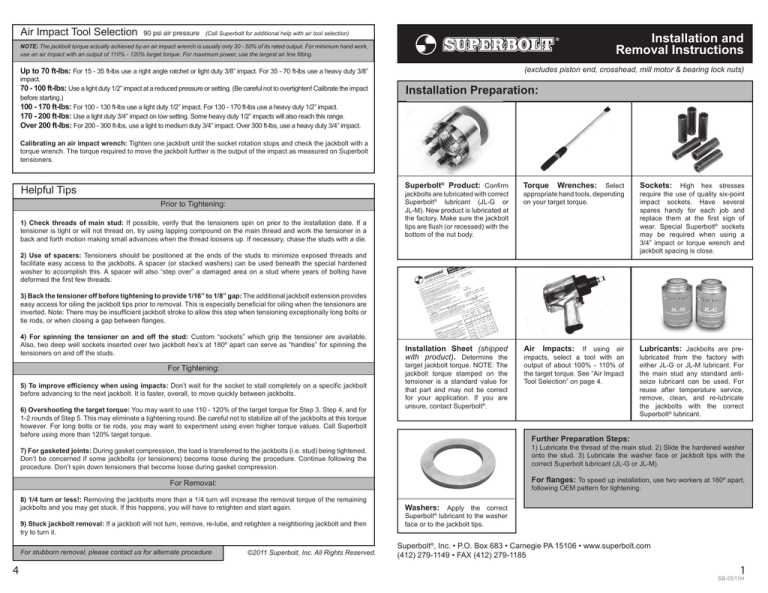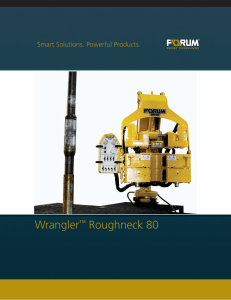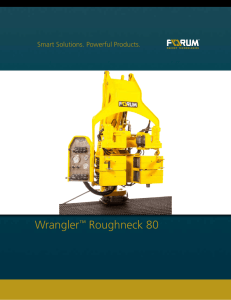
Air Impact Tool Selection
90 psi air pressure (Call Superbolt for additional help with air tool selection)
NOTE: The jackbolt torque actually achieved by an air impact wrench is usually only 30 - 50% of its rated output. For minimum hand work,
use an air impact with an output of 110% - 120% target torque. For maximum power, use the largest air line fitting.
Installation and
Removal Instructions
Up to 70 ft-lbs: For 15 - 35 ft-lbs use a right angle ratchet or light duty 3/8” impact. For 35 - 70 ft-lbs use a heavy duty 3/8”
(excludes piston end, crosshead, mill motor & bearing lock nuts)
impact.
70 - 100 ft-lbs: Use a light duty 1/2” impact at a reduced pressure or setting. (Be careful not to overtighten! Calibrate the impact
before starting.)
Installation Preparation:
100 - 170 ft-lbs: For 100 - 130 ft-lbs use a light duty 1/2” impact. For 130 - 170 ft-lbs use a heavy duty 1/2” impact.
170 - 200 ft-lbs: Use a light duty 3/4” impact on low setting. Some heavy duty 1/2” impacts will also reach this range.
Over 200 ft-lbs: For 200 - 300 ft-lbs, use a light to medium duty 3/4” impact. Over 300 ft-lbs, use a heavy duty 3/4” impact.
Calibrating an air impact wrench: Tighten one jackbolt until the socket rotation stops and check the jackbolt with a
torque wrench. The torque required to move the jackbolt further is the output of the impact as measured on Superbolt
tensioners.
Helpful Tips
Prior to Tightening:
1) Check threads of main stud: If possible, verify that the tensioners spin on prior to the installation date. If a
tensioner is tight or will not thread on, try using lapping compound on the main thread and work the tensioner in a
back and forth motion making small advances when the thread loosens up. If necessary, chase the studs with a die.
Superbolt® Product: Confirm
Torque
Wrenches: Select
appropriate hand tools, depending
on your target torque.
Sockets: High hex stresses
require the use of quality six-point
impact sockets. Have several
spares handy for each job and
replace them at the first sign of
wear. Special Superbolt® sockets
may be required when using a
3/4” impact or torque wrench and
jackbolt spacing is close.
Installation Sheet (shipped
with product). Determine the
Air Impacts: If using air
impacts, select a tool with an
output of about 100% - 110% of
the target torque. See “Air Impact
Tool Selection” on page 4.
Lubricants: Jackbolts are prelubricated from the factory with
either JL-G or JL-M lubricant. For
the main stud any standard antiseize lubricant can be used. For
reuse after temperature service,
remove, clean, and re-lubricate
the jackbolts with the correct
Superbolt® lubricant.
jackbolts are lubricated with correct
Superbolt® lubricant (JL-G or
JL-M). New product is lubricated at
the factory. Make sure the jackbolt
tips are flush (or recessed) with the
bottom of the nut body.
2) Use of spacers: Tensioners should be positioned at the ends of the studs to minimize exposed threads and
facilitate easy access to the jackbolts. A spacer (or stacked washers) can be used beneath the special hardened
washer to accomplish this. A spacer will also “step over” a damaged area on a stud where years of bolting have
deformed the first few threads.
3) Back the tensioner off before tightening to provide 1/16” to 1/8” gap: The additional jackbolt extension provides
easy access for oiling the jackbolt tips prior to removal. This is especially beneficial for oiling when the tensioners are
inverted. Note: There may be insufficient jackbolt stroke to allow this step when tensioning exceptionally long bolts or
tie rods, or when closing a gap between flanges.
4) For spinning the tensioner on and off the stud: Custom “sockets” which grip the tensioner are available.
Also, two deep well sockets inserted over two jackbolt hex’s at 180º apart can serve as “handles” for spinning the
tensioners on and off the studs.
For Tightening:
5) To improve efficiency when using impacts: Don’t wait for the socket to stall completely on a specific jackbolt
before advancing to the next jackbolt. It is faster, overall, to move quickly between jackbolts.
6) Overshooting the target torque: You may want to use 110 - 120% of the target torque for Step 3, Step 4, and for
1-2 rounds of Step 5. This may eliminate a tightening round. Be careful not to stabilize all of the jackbolts at this torque
however. For long bolts or tie rods, you may want to experiment using even higher torque values. Call Superbolt
before using more than 120% target torque.
Further Preparation Steps:
7) For gasketed joints: During gasket compression, the load is transferred to the jackbolts (i.e. stud) being tightened.
Don’t be concerned if some jackbolts (or tensioners) become loose during the procedure. Continue following the
procedure. Don’t spin down tensioners that become loose during gasket compression.
1) Lubricate the thread of the main stud. 2) Slide the hardened washer
onto the stud. 3) Lubricate the washer face or jackbolt tips with the
correct Superbolt lubricant (JL-G or JL-M).
For Removal:
For flanges: To speed up installation, use two workers at 180º apart,
following OEM pattern for tightening.
8) 1/4 turn or less!: Removing the jackbolts more than a 1/4 turn will increase the removal torque of the remaining
jackbolts and you may get stuck. If this happens, you will have to retighten and start again.
9) Stuck jackbolt removal: If a jackbolt will not turn, remove, re-lube, and retighten a neighboring jackbolt and then
try to turn it.
For stubborn removal, please contact us for alternate procedure
4
target jackbolt torque. NOTE: The
jackbolt torque stamped on the
tensioner is a standard value for
that part and may not be correct
for your application. If you are
unsure, contact Superbolt®.
©2011 Superbolt, Inc. All Rights Reserved.
Washers: Apply the correct
Superbolt® lubricant to the washer
face or to the jackbolt tips.
Superbolt®, Inc. • P.O. Box 683 • Carnegie PA 15106 • www.superbolt.com
(412) 279-1149 • FAX (412) 279-1185
1
SB-0511H
Removal
Installation
Step 1:
Step 2:
CAUTION!
Jackbolts must be unloaded gradually. If some jackbolts are fully unloaded prematurely, the remaining
jackbolts will carry the entire load and may be hard to turn. With extreme abuse, a jackbolt tip can
deform, making removal difficult.
Service Under 250ºF
Preparation: Spray jackbolts with penetrating oil or hydraulic oil prior to start (especially if product is in
corrosive environment).
Step 1:
Spin the tensioner onto the main thread
until it seats against the washer. You may
want to back off the tensioner slightly as
mentioned in Helpful Tip #3 on page 4.
Tighten (4) jackbolts at 90º apart (12:00,
6:00, 9:00, and 3:00) on all studs with a
partial torque (30-70%). This serves to
seat the flange. If using an air impact,
use a reduced setting or lightly pulse
the trigger at the full setting.
Step 3:
Step 4:
Step 2: Repeat a 2nd round as above for all
studs, now loosening each jackbolt 1/4 turn in a
circular pattern.
Step 3: Continue loosening 1/4 turn for 3rd and
Loosen each jackbolt 1/8 turn following
a circular pattern around the tensioner
(1 round only). As you move around
and get back to the first jackbolt, it will
be tight again. Do this for all studs on
the joint prior to the next step.
successive rounds until all jackbolts are loose.
NOTE: Usually after the 3rd or 4th round, an
air impact can be used to completely extract
the jackbolts, one by one. For long bolts or tie
rods, additional rounds may be required before
removing the jackbolts with an impact tool.
Step 4: Remove, clean and relubricate the
jackbolts prior to next use with correct Superbolt
lubricant (JL-G or JL-M).
Service Over 250ºF
Preparation: Above 300ºF the petroleum base of the lubricant burns off. Oil per “STEP 1” below to
reduce the removal torque.
At 100% target torque, tighten the same
(4) jackbolts on all studs.
Step 5:
Repeat “STEP 4” until all jackbolts are stabilized (less than 10º rotation). This usually requires 2-4 additional passes. If using
air tools, switch to a torque wrench when
socket rotation is small. Use the torque
wrench to stabilize at the target torque.
2
At 100% target torque, tighten all
jackbolts in a circular pattern. Do this for
all studs (1 round only). See Helpful Tip
#6 about using up to 120% torque.
Step 1:
OIL
NOTE: Product with 4 or 6
jackbolts - use a star pattern for
all steps.
Step 2: Wait for tensioners to cool below
200ºF. Using a circular pattern, “crack” each
jackbolt only enough to ensure movement. Do
not turn beyond the break loose point. Do this
for all studs.
Step 3: Now begin with “STEP 1” of the
procedure for service under 250ºF.
As the equipment is cooling down
(around 300ºF), apply hydraulic oil to
the jackbolts and washer and let sit
for several hours. Thoroughly “wetdown” all components and re-apply
during equipment cool down period. If
the tensioner is inverted, squirt oil in
the gap between the nut body and the
washer. Synthetic oil can be used for
oiling above 300ºF.
NOTE: Heating Rods can be used to reduce the
removal torque required.
3






